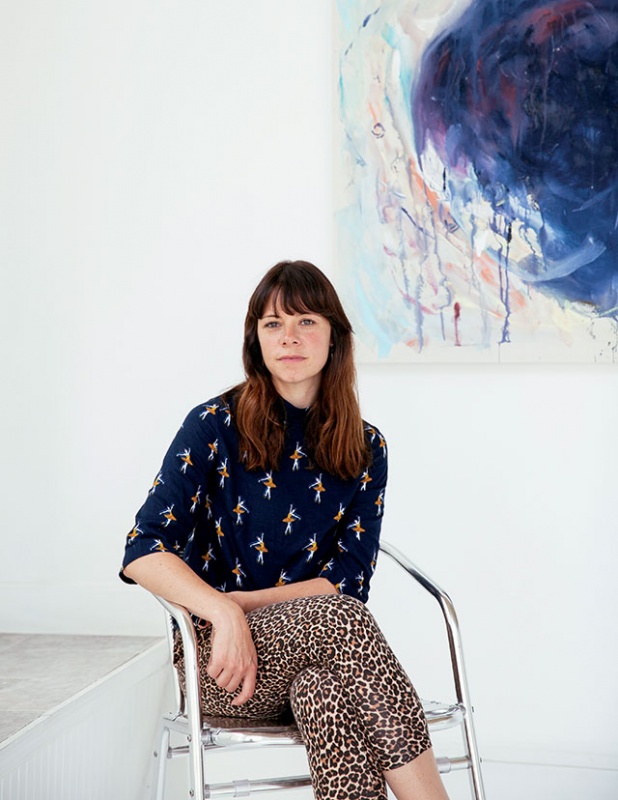Real Artists, Real Humans
Photo by Attilio D'Agostino
ALIVE_Volume-15-Issue-4_ART-2_640x427
It’s one of those wet spring mornings in St. Louis, the sky a milky gray and the air so dense you could drink it. Driving through the neighborhood, past the swaying oaks and quiet sidewalks, the prospect of encountering high art around the corner seems as likely as rear-ending a giant beanstalk.And indeed there is something magical about first discovering Parapet Real Humans, an art gallery co-founded in September 2015 by visual artist Amy Granat and her Berlin-based collaborator, Annina Herzer. Seated unassumingly on the leafy corner of Sidney Street and Nebraska Avenue with the original wood of its storefront windows veiled in thick brushstrokes of paint, it could easily be mistaken for a business in transition or an unconventional residence. As Granat opens the door, she reveals clear green eyes and youthful zest undulled by her decades of art-world experience. Stepping into the space itself is like drifting inside a cloud—the walls and floor a soft white, illuminated by the sun alone. Modest in scale but airy, with an original tin ceiling at least 18 feet high, the room blurs the line between public and domestic.“The idea to do Parapet Real Humans grew very organically from my life,” Granat explains after graciously offering a bottled water. “I had gone through many transitions, and wanted to make my professional life blend with what was happening now—both with being a new mother and being in a different kind of city.”A St. Louis native who left in the early ’90s to pursue a BA at Bard College, Granat spent the next 20 years in New York and Berlin, swiftly gaining considerable renown for her structuralist-influenced film projections—showing at galleries in Europe, New York, and Los Angeles, but rarely in her place of provenance. Returning to St. Louis in early 2014 to raise her baby, Granat took the move as an opportunity for renewed creative rigor—both personally and in a broader way that engages the community. As an artist of light—her video installations chronicle the sound of light itself—her attunement to its power is evident in Parapet’s design, which has a hushed, homey quality even while resembling the classic white cube gallery space.Unlike the “pop-in-pop-out” circuit dominating New York’s Chelsea or Upper East Side, Parapet features only one artist and one work at a time. Crucially, the artists take an active part in all gallery openings. “Parapet is the antithesis of the art-world conveyor belt; you have to make an appointment to come here, and our openings revolve around concentrated discussions with the artists themselves,” Granat says. Each discussion is led by a St. Louis local, such as James McAnally of Temporary Art Review and The Luminary; or Ann Marie Mohr, co-founder and director of Onsite Theatre Company.“What I love so much about it,” she continues,“is that it gives people a deeper, closer look at contemporary art and artists, something very unique to St. Louis.”Traveling to Tower Grove East from across the country, the artists featured thus far include Los Angeles-based painters Jacob Kassay and Mark Hagen, Swiss artist Olivier Mosset, Zurichbased sculptor Bleta Jahaj, LA-based filmaker Drew Heitzler and Milwaukee-based artist John Riepenhoff, whose “Plein Air” painting from his “Night Sky” series greets visitors upon arrival.“A lot of these artists are showing at blue-chip galleries,” says Granat, referring to the artworks’ sale value. “This is a very unique opportunity for them to talk spontaneously about their process to those outside of it. Everyone has been so excited to come here, and it’s amazing to see artists of this stature in an intimate, salon-like atmosphere.” Each opening, chairs are brought out and visitors are encouraged not just to sit and passively listen, but to ask questions of the artists.Describing her vision, Granat says, “It’s a true reflection of art meeting life. The experience between artist and audience is very human, where the term Parapet Real Humans comes from. It’s about making space for something that isn’t there otherwise. For conversation, to slow down, to look again.”This story comes from ALIVE's Let's Come Together issue. Read more from that issue online, or find where you can pick up a copy around St. Louis.


